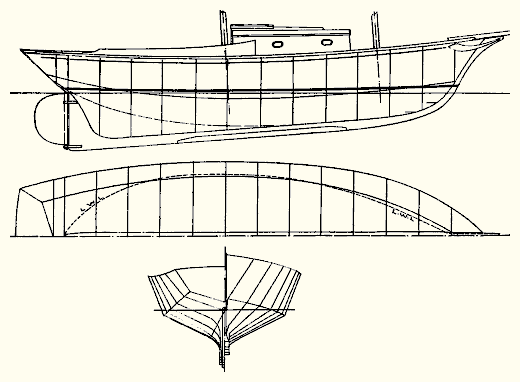

 |
America Junior A 25' 8" V-Bottom Schooner By William Atkin |
| A Delightful Little Schooner for Day Sailing and Extensive Cruising | |
America Junior is not a small scale model of America. It has the air of that marvelous old schooner which I understand is the only yacht that has sailed for the "Cup" which still lives. The sail plan has the characteristics of the original; the dipper bow is similar; the above water and under water profiles are not unlike the masterpiece of George Steers; and the simplicity of the entire design reflects the original. | |
 |
|
The overall length of this little packet is 25 feet 8 inches; the water line length, 21 feet 6 inches; the breadth, 8 feet 6 inches, and the draft, 3 feet 3 inches. Ample in the latter not to require a center-board. The freeboard at the bow is 3 feet 1 inch; at the lowest place, 1 foot 11 inches; and at the stern, 2 feet 3 1/2 inches. The piece of ballast in the keel will weigh 1000 pounds; with 500 pounds distributed inside either side the keel and between stations 4 and 8 inside. It is always good practice in a cruising boat to carry a good proportion of the ballast inside. It has less pendulum effect this way and tends to slow down quick rolling and pitching.
The sail plan shows masts with a sharp rake, nicely steeved bowsprit, stub top-mast on the main, no spreaders, jumper struts nor permanent back-stays. The total sail area is 340 square feet.
Sailing a small schooner is fun. By proper trimming of various sails this kind of rig can be made to do anything. People will begin to say after a while, "Why, that little boat is well behaved; she can go anywhere; just like a motor boat." And, that, indeed should be a tribute to any sailing vessel. Everything aboard America Junior is small and light, easily handled and handy for one man to sail alone. With two; well, what more can one wish for? |
|
 |
|
The cabin is laid out for two. You can pile more in if you wish but two form an ideal crew for any small boat. The headroom under the sliding hatch is just 5 feet, while there is 4 feet 5 inches under the house top beams in the center of the deck house. Some one who has sailed many miles in yachts of all kinds says that unless one has full head room it is just as well to reduce this to a minimum in a small boat so long as there is comfortable sitting-up room. And this is undoubtedly so. I have noticed that most sailors sit down when below; but always stand up when on deck. They must have caught this from that painting of General Washington crossing the Delaware. And the smaller the boat, the more they stand up. With the coal range, sink and drop table attached to the side of the sink top, a good fire going, a cold wind outside and an understanding shipmate alongside what more can one, ask of the Gods? Some coffee perhaps; some hot rum; and a prayer and toast for better days to come.
The lines of America Junior show a skipjack or V bottom hull of easy proportions. Not too wide, not too much draft, not too much freeboard, and a nice distribution of overhand at the bow and at the stern. All the forward sections are straight lines, the bottom and topsides. The bottom sections aft have hollows leading into the keel and deadwood but above the chine are straight lines. While this, complicates the building it is more than worth while because it forms a far better run as the hull leaves the water, and adds a lot of depth and room for the motor installation. The rudder post stands at right angles to the load water line. This locates the center of the lateral plane well aft, which is highly desirable in a yacht with schooner rig. The keel forms a straight line from station 3 to the rudder post. And, it will be noted, has wholesome drag; but the forefoot is not cut up badly in accomplishing this. |
|
 |
|
In rough water this hull will not slam around. It will hold on in a breeze. It will not yaw all over the place when running off a strong wind and sea, and will be exceptionally dry consideringthe small size of the craft. Thanks to the modest weight of the ballast and because it is happily distributed fore and aft and partially outside and inside, the little schooner will be comfortable in bad weather.
The motor shown in the plans is an old fashioned single cylinder two cycle without clutch or reverse gear. There are still lots of these around to be had second hand. And good they are. I had one of these in Great Republic which was as old as the industry itself; cost five dollars and about the same to put it in repair. It is still a very good engine. Of course one has to crank this kind of outfit; but that is good for the back and rather fun in the bargain. |
|
Plans for America Junior are $125 |
|
| BACK TO PLAN LIST | |